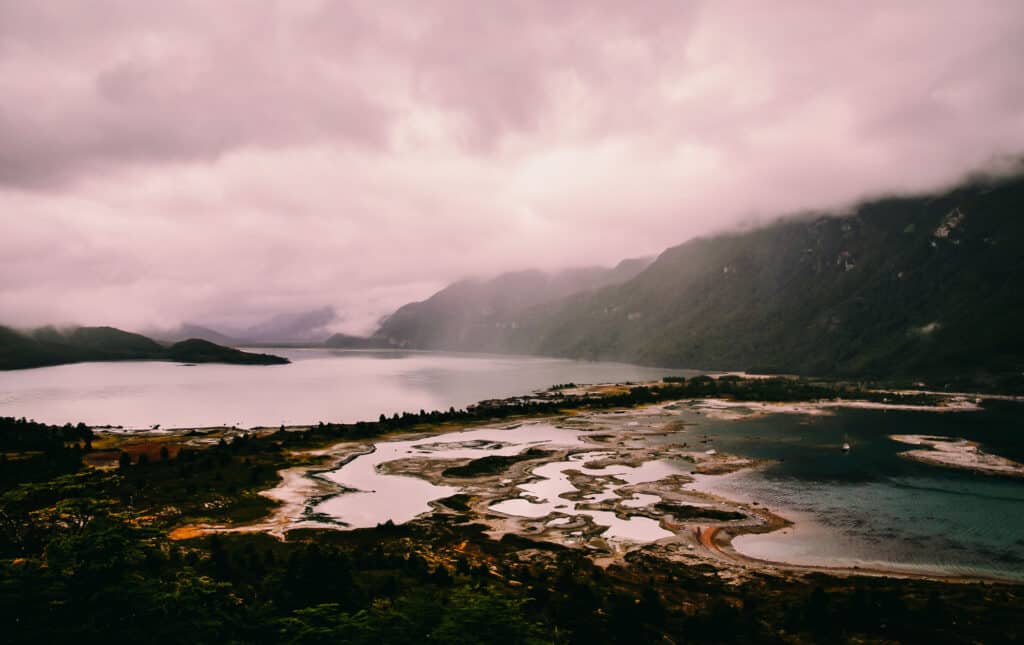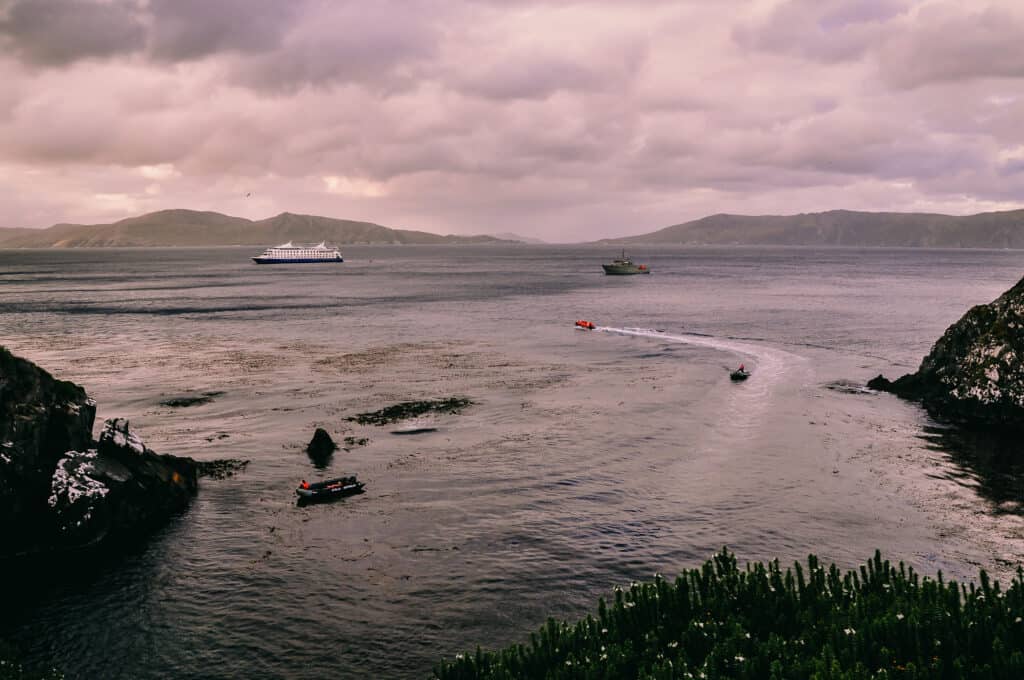Cruise | Cape Horn, Patagonia | Chile
A cruise to Cape Horn - my most memorable birthday yet
Text | Anninka Kraus
Photography | Tobias Kraus

Chile Patagonia
Birthdays have started recurring at alarmingly shorter intervals but I quite like the notion that I often spend mine at fairly remote places. I rest assured that at least the first day of a new year in my life is memorable and not drowned in the monotony of routine. That entails any kind of memorable though, as on a previous birthday, Battambang certainly made a lasting impression in the categories tagged ‚awfully boring’ and ‚lacking anything remotely interesting’.
At breakfast we were happily surprised to share the buffet with only South American families, including grandparents and their grandkids. That had never happened to us when we travelled in South East Asia, meeting locals as guests in upscale hotels, which they could obviously not afford.
At noon we checked in at the Cruceros Australis office in town for our cruise to Cape Horn, were allocated a room on deck 4 and a table for six by the window in the Patagonia dining room, and immediately ascertained that we were considerably lowering the average age, by double digits, but could not openly comment the fact in German. There seemed to be an equally sizeable number of German and American couples in their early sixties on board dressed as though to withstand the fiercest storms and arctic temperatures for weeks, in case they were accidentally left behind in the wilderness on one of the excursions.
To ensure this year’s ‚memorable’ would be boasting in categories tagged ‚wellness’ and ‚scrumptious’ I felt compelled to spend an hour in the spa, enjoying an aromatic oil massage – why is it that in hotels masseurs barely tickle your skin? – and a giant piece of blueberry poppy seed cake. At 6 we passed strict airport security checks at the dock and, though more than on time, were among the last to arrive.
We screened the gathering of pensioners in disbelief and my pained expression must have shown – it’s terrible, I’m an open book always – because this guy walked past, laughing, ‘I’m also just 40’. Like that would have rejuvenated the rest.



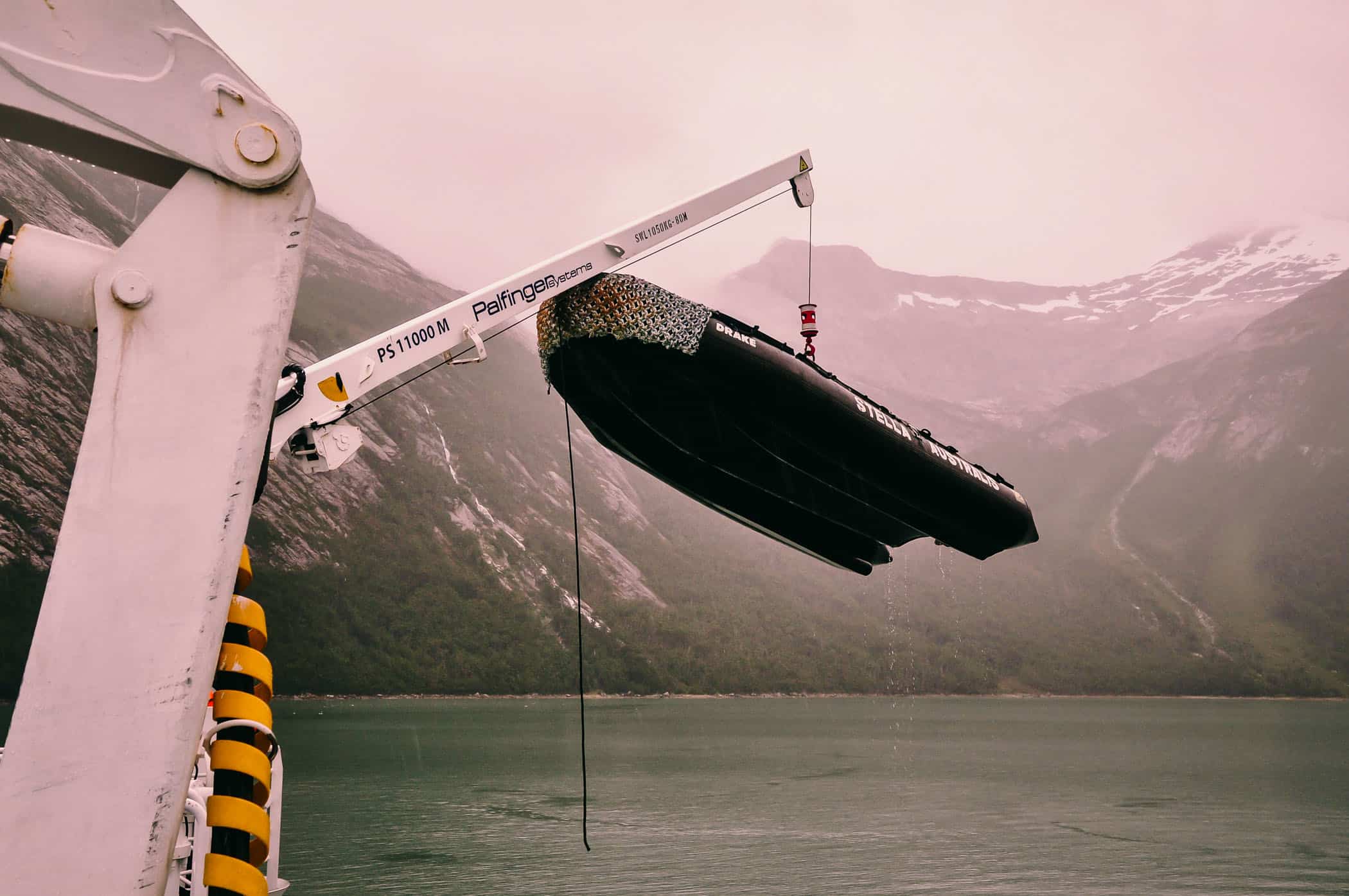

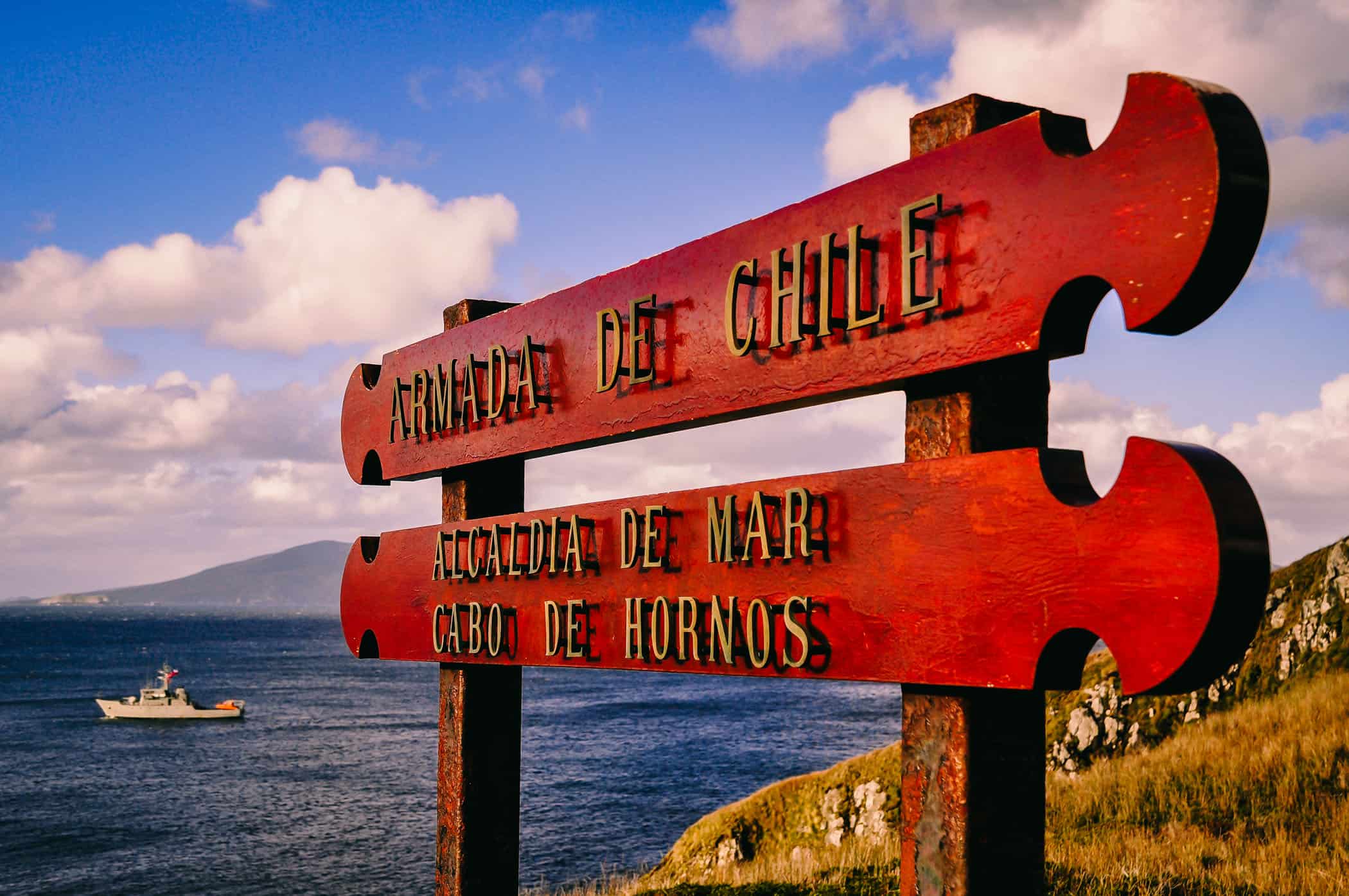



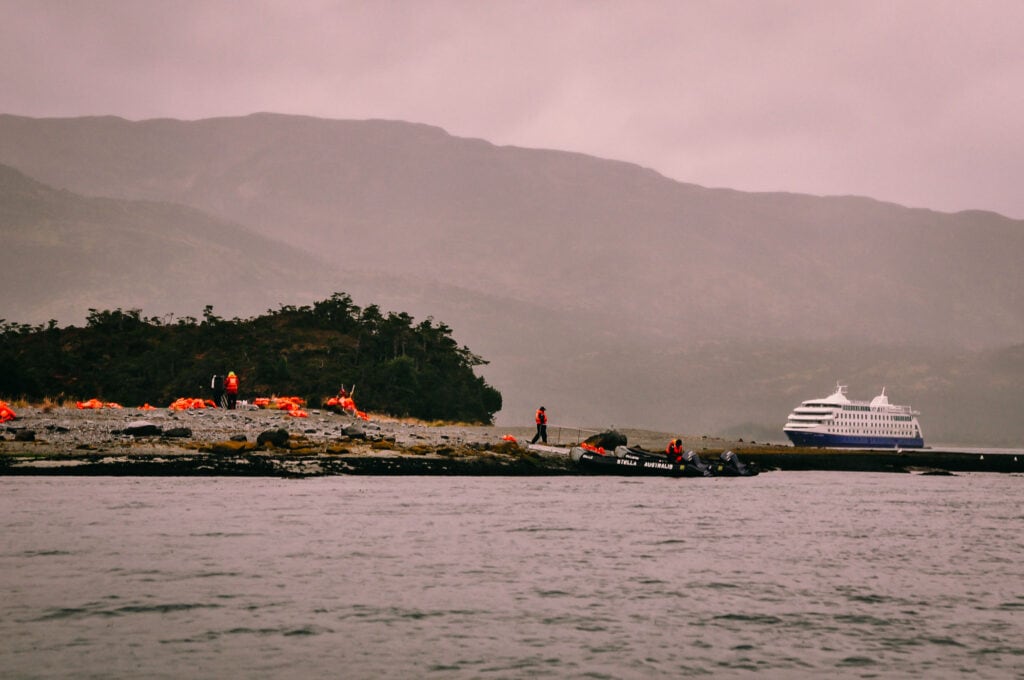
We were asked to board a coach to cover a distance of less than 300m along the dock to the Stella Australis, and as I was just drawing breath to comment on how unnecessary this was, I watched some passengers awkwardly floundering up the few steps into the bus and shut my mouth. On board we were asked to deposit our passports at the reception and personally escorted to our cabin.
In fear of sounding like a snob, it was the most wonderful decision to book the most expensive cabin category on board. But then this cruise is astoundingly expensive even in cattle class, so I thought one might as well stretch the extent of ‚expensive’ and add that tag to ‚memorable’. The entire ship, taken into operation in 2011, was in excellent condition and the cabin in subdued colours quite spacious and comfortable. The small bathroom reminded me of our hotel room in Tokyo, the tiniest we’ve ever stayed in, for the little space was so ingeniously apportioned that its lack in size without compromising comfort caused me daily astonishment.
The service was comparable to what I imagine all-inclusive hotels offer: daily room service, entertainment, and full board including drinks. We were more anticipating the excursions with zodiacs, lightweight inflatable boats, and adjusting to the gently rocking daily life on board the ship. On second thought, considering our particular destination, maybe less gentle. The notion of reaching the southernmost tip of the American continent at 55°56’S and 67°19’W, the last stop before Antarctica, is dazzling as neither the Cape of Good Hope nor Stuart Island in New Zealand lie this far south and more than 800 ships have sunk, killing more than 10.000 sailors in their attempt to circumnavigate the cape. Despite the tiny pinpoint’s terrible reputation, one is nowadays assured by the crew that joining anyone involuntarily at the bottom of the sea is considered a very unlikely event.
We met the first +60 couple from Sydney during the security briefing in the lounge on deck 5 and clinked welcome drinks to a wonderful voyage. As we were exchanging the cautious chatter common to most casual first acquaintances with considerable age gaps, I wondered how much socialising would await us in the upcoming days. I’m an introvert and quite happy doing little. The occasional other younger couple we met, mostly kept to themselves, no great extroverts among them either.
We had yet to meet the four guests joining us at dinner table number 35 and were placed with two couples ranging in age from mid 50s to 75. One might say that we occupied opposing ends of a communicative spectrum. It started off with a harmless ‘Where are you from?’ Because that’s like a yes or no answer, there followed, ‘What do you do?’ ‘Where and when did you meet?’ ‘Are you married?’ Affirmative. When we negated kids one of the ladies really did want to know, ‘Why not?’ and, ‘When?’
By the end of our 4-course dinner the shy introvert in me felt slightly drained by this inquisition and hoped, that since we had already disclosed anything and everything today, that one would usually only divulge after many years of friendship, all topics of conversation were exhausted and the next meals would pass in silence. No such luck fortunately, because their easy chatter at the first dinner broke the ice, and once I’d recovered from my feelings of uneasiness and vulnerability, we enjoyed many lovely, and interesting conversations. An outsider must find it most amusing though, to watch a randomly united group of such different personalities and cultures interact.
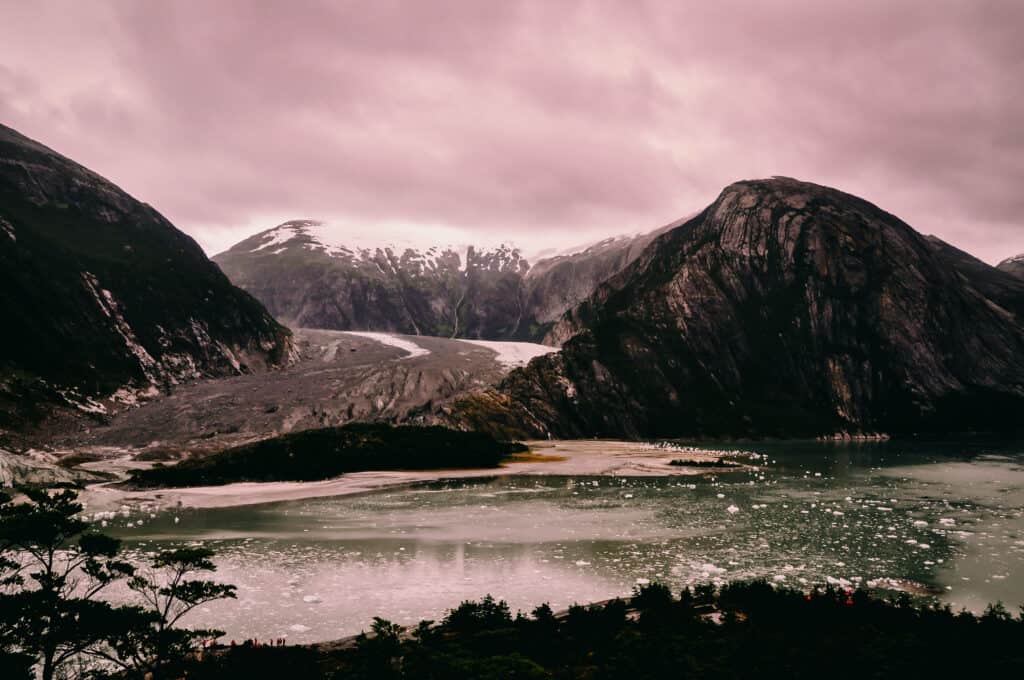
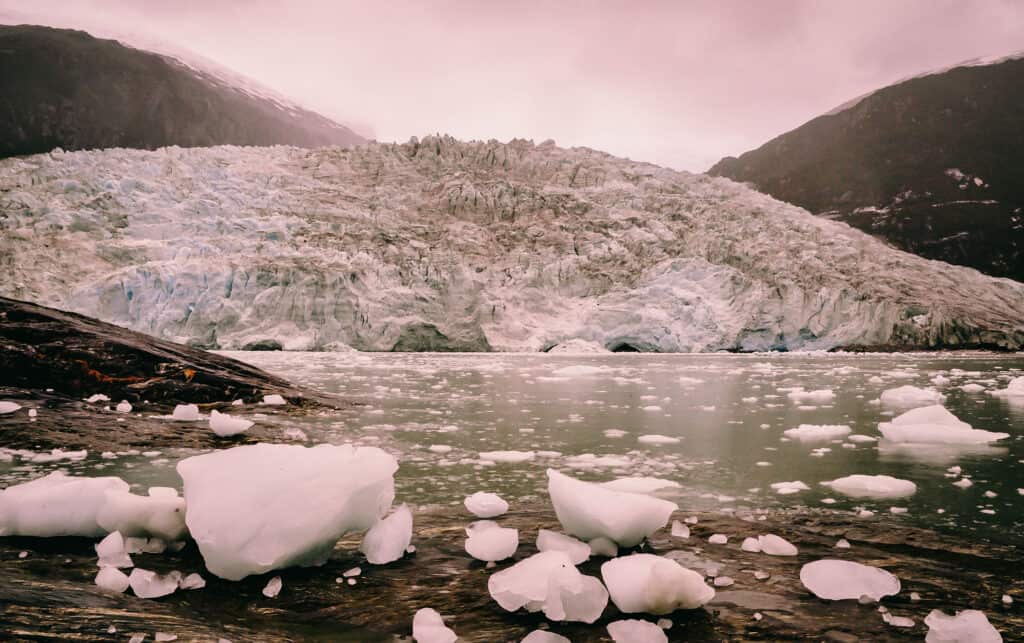
Just as we were rehearsing excuses to leave, and diners started getting up, the most embarrassing scene unfolded. The captain stood up in the middle of the room, microphone in one hand and balancing a pineapple cake with four candles in the other, announcing a birthday girl on board. The millisecond’s hope that there might be a pineapple-eager four-year-old celebrating with me was instantly squashed when the captain started walking towards our table. But wait for it got worse – when I was inwardly pleading, ‘Please, please, someone make him stop’, the leader of the expedition team, the first engineer, and the captain started singing Happy Birthday for me in Spanish. And there I stood, turning a deeper shade of crimson with each verse, while trying to look inconspicuous, which in the midst of nearly 200 passengers is quite impossible.
I was hugged and kissed, blew out the candles, accepted congratulations in several languages, and admitted that I had now had my share of ‚memorable’ for this birthday. Ready to run from the dining room, I was accused by the Americans of having withheld vital and thrilling news from them during dinner. Even three days later other passengers still wished me belated happy birthday in the corridor, and the captain and expedition leader addressed me by name for the entire cruise.
We had upped the anchor at 8pm and were on our way to Ainsworth Bay, 90 nautical miles southeast. The gentle sway was more noticeable on the upper decks, where we had after dinner drinks, than in the dining room on deck 1. When we sleepily retired to our cabin, we lay on the bed for some time just watching darkness and the vague outline of the light swell outside the 2m wide floor-to-ceiling window. I wanted to ceaselessly watch day and night float by from a bird’s-eye perspective but still so close to the waves that the spray might have drenched us with freezing Patagonian seawater. Might have, but of course didn’t, as we were snuggled up under the covers and watched the frothing bow wave level off towards the rear and sparkle in the faint ship’s lighting. The steady rise and fall of the Stella Australis literally rocked us to sleep.
On Sunday we marvelled at the vast breakfast buffet before setting out on our first zodiac excursion to Ainsworth Bay, one of five zodiac trips altogether. It was twelve per boat sitting on hard rubber and holding on for dear life. Nobody wanted to fall off, despite safety vest and dolphins. We had opted for the ‚high difficulty excursion’ with only about 20 others of who most managed a walk on the flat but started stumbling and huffing up the merest uneven, slightly muddy slope. We would have loved some more exciting and longer hikes but observing the ‚high-difficulty’ troop figured that wasn’t such a great idea.
Nevertheless, even up a little hill the panoramic view of the numerous islands, fjords and the terminal moraine – legacy of several glaciers in this region – was impressive. The composition of the Stella Australis reduced to the size of a miniature toys in the bay looked like Hurtigruten advertisements. On our way back, the zodiacs stopped mid-way on a shelf of rock where a little table had been set up and some of the crew served hot chocolate and whiskey. I gladly received the hot chocolate to warm my numb fingers. The temperature without wind chill averaged around 5 degrees, and even my wind- and waterproof gloves didn’t fully stand up to the biting gusts.
In the afternoon we clambered into the zodiacs again to the Tuder Islets some 30 sea miles away but did not disembark so as not to disturb the Magellanic penguins and cormorant colony. Similar to Isla Magdalena the penguins had returned to breed here in spring, and the young, though already grown, were still noticeably chubbier and fluffier than their parents. The cormorants stank terribly, or rather the large-scale greyish guano fields below their breeding grounds on steep cliffs did. High above the sea they perched one next to the other, surrounded by various types of sea gulls, and set off to dives from time to time. Possibly to escape their pungent stink.
Otherwise they appeared to do little else; I will never become a bird watcher in fear I may die of boredom and the stench. The bumpy, rapid cruise in the small boats was great fun though, but I realized that a ride could indeed be very wet and dangerous in heavy swell. From the upper deck of the ship the choppy sea bore no relation to the zodiacs that seemed to float above the water unperturbed. But sitting inside one of the rubber dinghies, hanging on for dear life, the perspective was a very different one. More like that of a Magellanic penguin awkwardly summersaulting ashore.
That night at dinner, I discovered amusing cultural differences between the Americans at our table and us. Far beyond the stereotypical humourless white knee-highs in sandals (if there is anyone still doing that, could you please stop) and obese Simpson characters flashing guns. As they seemed to know everything there is to know about us, we thought we were entitled to ask, ‘And what do you do?’ When you ask a German, the answer will generally be short and dull, something along the lines of, ‘I’m an engineer’, ‘A waitress’, ‘Accountant’, or sometimes, ‘Not much’. One word, three max.
It’s so much more entertaining to ask an American. Cooked dinner last night? Keep a personal diary? Member of the school choir some thirty years ago? Go for a run once a week? Twenty minutes? That will do. Helped your kids with colour by numbers? Fabulous! You are now a cook, author, singer, athlete and artist. I admit to some slight exaggeration, however I felt enthused by such pride and confidence in one’s abilities. What a boost to your self-esteem!
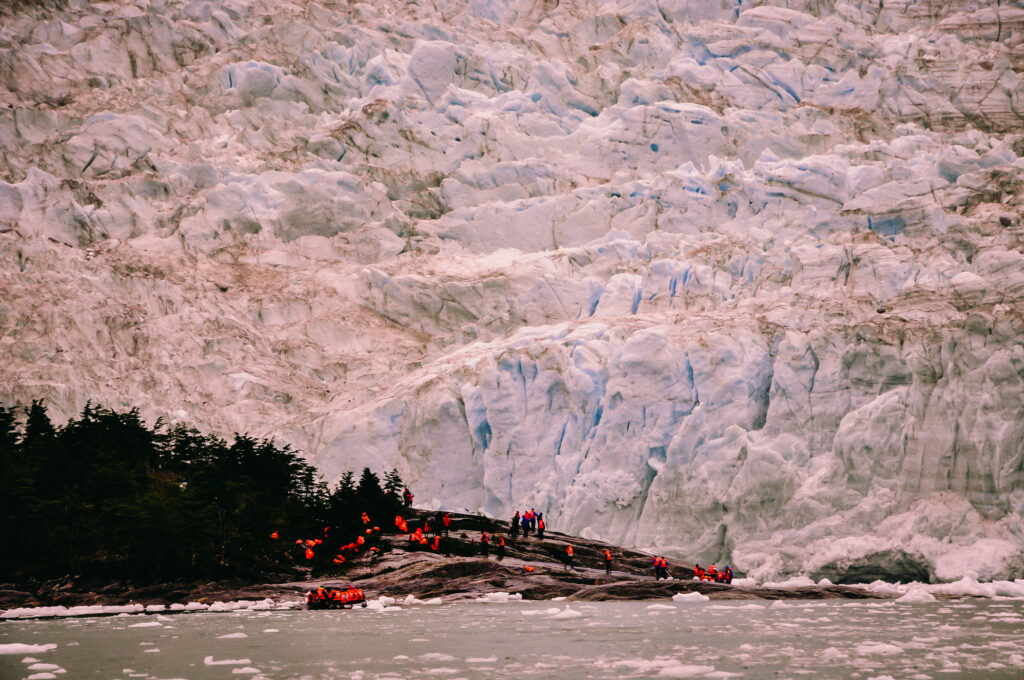
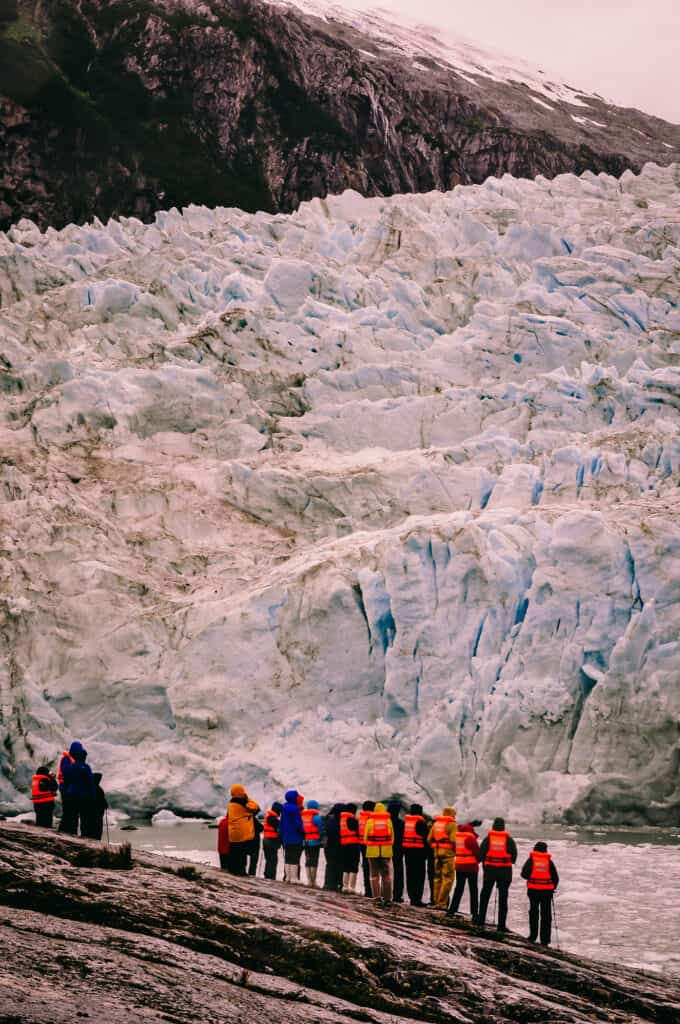
During the night and the following morning, we covered 208 sea miles to Pia Glacier and enjoyed the passage through the Beagle channel on Monday morning from the Darwin lounge on deck 5. Unfortunately, the weather was as inhospitable as expected in Patagonia – wet and cold, our surroundings mostly shrouded in clouds. I haven’t read the book nor watched the movie but just the title itself ‚50 shades of grey’ described the countless nuances of white and black of the sea, fjords, islands and moraines tremendously well. Every photograph was a textbook example of elaborate black and white photography, and only the obligatory bright orange safety vests added splashes of colour on deck.
We visited the navigation bridge and were impressed by how little resemblance it bore to our erroneous, much out-dated notion of such a command centre. The wooden wheel, the only feature consistent with the Titanic bridge, was a miniature version of its proper predecessors and antiquated remnant of the past. It was also sadly overtrumped by flashing on-board computers, radar screens and some magic electronic wall that mysteriously piloted us through the narrow fjords. I was as much fascinated as disappointed by these charmless clever devices but in light of today’s resources all the more in awe of the skills of one Fitz Roy. We’d heard about the British captain, one of the greatest seafarers and explorers of his time, in a lecture the previous night, who aged 23 took command of the Beagle – aboard Charles Darwin – and explored the world’s most dangerous, remote and adventurous places.
After lunch we crossed over to Pia Glacier on zodiacs. Even though we stood behind an abandoned moraine, separated from the glacier by a narrow estuary on which several shiny, transparent ice sheets floated, the perspective was very different to that of Grey glacier in Torres del Paine National park.
Pia towered up to 400m above us, a colossal ice mass, rugged and fissured and constantly moving. A lecture on board had illustrated the movement of the glacier very well: One photograph taken every day for a year shown in fast-forward. We were astonished to see the ice perpetually stretch and contract in various directions, relentlessly moving back and forth. It was like watching one of those documentaries that film people in a sleep laboratory for a night and shows their restless pillow kickboxing sessions in fast-forward.
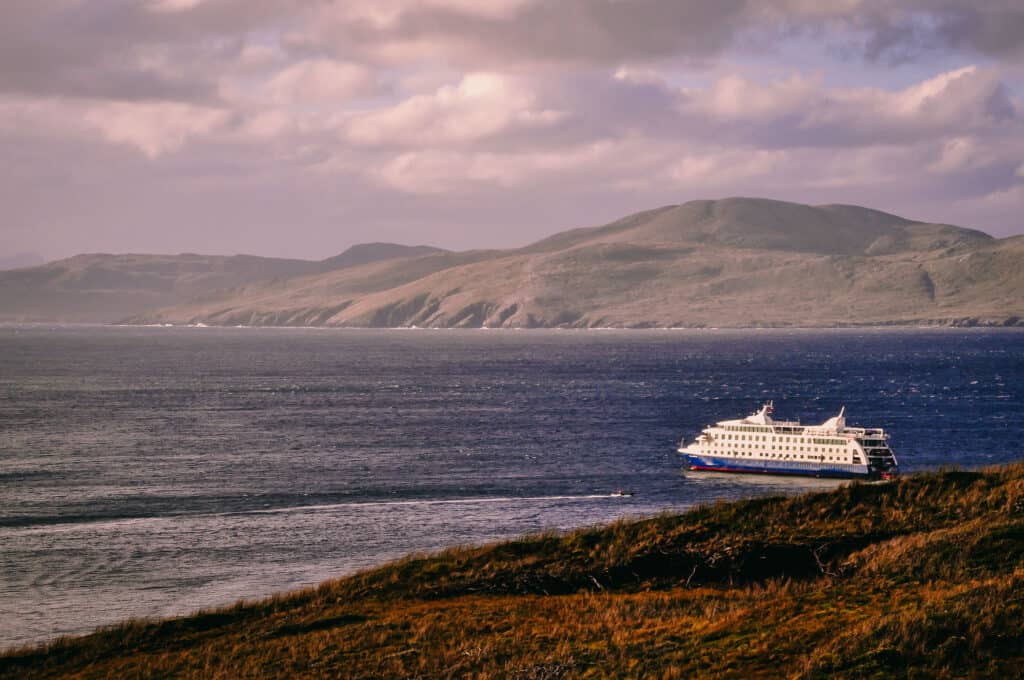
Mesmerised by frozen water, dirty frozen water, for the glacier’s surface unlike the floes was covered with debris, we jumped when the first thundering roar echoed across the strait. A huge chunk of ice, slightly dwarfed by the size of the glacier, broke off and tumbled into the sea with a huge splash. Because the rumble did not reach us until after the piece was swallowed by seawater, we engaged in a team building exercise with the other passengers of ‚spot me if you can’ to spy the next chunk bidding farewell to the furrowed pile. We were again engulfed in grey today but for tiny refreshing specks of green bushes, orange life jackets and the piercing, very light bluish-green colour of newly revealed glacial ice.
On our way back there was another hot chocolate and whiskey stop, and I believe some gents took incredible pleasure in plunging small shreds of glacial ice into their whiskey glasses.
We left Pia Fjord and continued our passage through the Glacier Alley. While sea lions, penguins, sea birds and dolphins were constant companions, we spotted our very first whale that night. I was thrilled to watch the huge tail fin rise in an elegant arch and plunge back out of sight. First time anythings are always exciting especially since we were very much spoiled for glaciers that day. They kept appearing left and right adding ice blue candy sparkle to the dreariness, and several reached right down to sea level. Some I may have missed because I was still on the lookout for that whale which unfortunately had not reappeared when dinner was announced.
I must admit that I am a very weather-sensitive person, with an insurmountable aversion to the cold, fog (I have come to hate that even more in Switzerland), grey skies, towering black clouds, any kind of precipitation, and a particular dislike for snow. On the countless times I have complained about awful weather ruining my mood – and in Switzerland there’s an awfully long period in which I have ample reason to complain, more or less three quarters of the year – my Mum has gently reminded me, just as many times, that Nelson is indeed the sunshine capital of New Zealand and never sees snow. Thank you for reminding me and for pointing out that Patagonia is an unusual place to go to catch some sun.
Just as the colour grey was seriously getting on my bad side, the next morning surprised us with blue skies. At least patches of blue surrounded billowing grey clouds. We anchored in Wulaia Bay for an early breakfast on our last day on board and boarded the zodiacs to Isla Navarino shortly after.
We went ashore in Wulaia Bay where Fitz Roy and Charles Darwin encountered the Yaghan in the first half of the 19th century and hiked up an elevation for a spectacular view of the bay. Halfway up it started to drizzle. We took a stance against grey and adorned ourselves with the most garish, hideous raingear, and continued walking into even heavier fog and stronger rain. By the time we reached the viewpoint, blue patches were reappearing, and the insidious drizzle stopped long enough to take in the wonderful panorama.
The ship was again shrunk to the size of a peanut bobbing on the water and surrounded by small islands and larger landmasses farther out. A rainbow, its colours faint but beautiful on the rugged canvas, spanned across the bay. With the sunlight the colours intensified and revealed the vegetation’s many shades of brown and green and the murky blue of the South Pacific. Last cup of hot chocolate on the way back, and we were off to the southernmost headland of Tierra del Fuego, Cape Horn.
For all the sagas and myths surrounding this location, the small rocky island itself is quite unspectacular. Overgrown cliffs rise steeply from a narrow strip of shingle beach. Out of all the passengers, I believe nobody sat out that day. We were ferried across on zodiacs by crewmembers braving the chilly winds in wetsuits. Some 150 wooden steps led up the 425m rocky promontory to a grassy plain on which stood a small gathering of wooden buildings and the Chilean flag hissing on a flagpole.
A tiny chapel, a lighthouse and a red building, are the temporary home of the naval officer that presides over this outpost. Several hundred applications are received for this position every year. I mused what incentive, honour or money, was attractive enough to condemn one’s family to utter isolation in one of the most remote places on earth. A triangular modern art sculpture sits at the tip of a headland some distance away, the Cape Horn Memorial. Half of it is gone, broken off in a storm.
As this memorial honours the sailors who braved the storms, I quite appreciated the irony. While we were walking along a wooden boardwalk leading to the metal sculpture away from the outpost, a navy helicopter touched down on a small landing space and dispelled some of the ‚solitary bottom of the word’ atmosphere. On the way back, we passed the white Monument of the Unknown Sailor from 1989, the inscription for some absurd reason in French.
We considered ourselves very lucky to have had the right weather conditions to disembark on Isla Hornos. Many places on this Earth are far more beautiful than Cape Horn, but it stands unrivalled in its feeling of exploration and adventure, remoteness, hazardous waters, and strong winds. So inhospitable and dreaded by generations of seafarers, that its sense of place is all the more profound.
We woke to a blue, nearly cloudless sky – why, only on the last day – just off the coast from Ushuaia the next morning. Disembarkation after nearly 600 nautical miles aboard the Stella Australis was a tad impersonal and brusque. Sad really, because it did make you feel like the service, which had been outstanding, ended when handing over the tip for the crew. Our luggage was deposited on the pier in a pile with everybody else’s and people waded through suitcases in search of their own. No coach waited at this end – reminder to myself: I did think of it as unnecessary only four days ago – and we walked to the nearest taxi stand. On the short trip to the airport, the capital of Tierra del Fuego seemed like a sleepy, colourful little place surrounded by snow-capped mountains from where you can set out for hikes into the nearby Tierra del Fuego National park. Next time.
